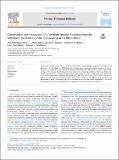Files in this item
Conservation and restoration of a keystone species : understanding the settlement preferences of the European oyster (Ostrea edulis)
Item metadata
| dc.contributor.author | Rodriguez-Perez, Ana | |
| dc.contributor.author | James, Mark | |
| dc.contributor.author | Donnan, David W. | |
| dc.contributor.author | Henry, Theodore B. | |
| dc.contributor.author | Møller, Lene Friis | |
| dc.contributor.author | Sanderson, William G. | |
| dc.date.accessioned | 2018-11-28T14:30:07Z | |
| dc.date.available | 2018-11-28T14:30:07Z | |
| dc.date.issued | 2019-01 | |
| dc.identifier | 256732944 | |
| dc.identifier | fe31784b-c814-4d63-9480-5acc2eca7f18 | |
| dc.identifier | 85057183622 | |
| dc.identifier | 000457512500039 | |
| dc.identifier.citation | Rodriguez-Perez , A , James , M , Donnan , D W , Henry , T B , Møller , L F & Sanderson , W G 2019 , ' Conservation and restoration of a keystone species : understanding the settlement preferences of the European oyster ( Ostrea edulis ) ' , Marine Pollution Bulletin , vol. 138 , pp. 312-321 . https://doi.org/10.1016/j.marpolbul.2018.11.032 | en |
| dc.identifier.issn | 0025-326X | |
| dc.identifier.other | RIS: urn:476588928C038E931C3C3E43384B7F06 | |
| dc.identifier.other | ORCID: /0000-0002-7182-1725/work/57330875 | |
| dc.identifier.uri | https://hdl.handle.net/10023/16569 | |
| dc.description | The project was funded by the Nesbit Cleland Trust (St Abbs Marine Station), Royal Haskoning DHV and Scottish Natural Heritage with additional support from the Dornoch Environmental Enhancement Project (DEEP: a partnership between Heriot-Watt University, the Marine Conservation Society and the Glenmorangie Whisky Company: A15R10520) and the MASTS pooling initiative (the Marine Alliance for Science and Technology for Scotland) funded by the Scottish Funding Council, United Kingdom (grant reference HR09011). Additional funding was provided by a MASTS PECRE grant. The authors wish to thank the staff of the Danish Shellfish Centre for their kind support. | en |
| dc.description.abstract | The European oyster Ostrea edulis is a keystone species that is internationally recognised as ‘threatened and declining’ in the NE Atlantic by OSPAR and several nations have consequently adopted strategies for its conservation and restoration. Understanding the settlement behaviour of O. edulis larvae is crucial to inform these strategies. We compared the efficiency of several treatments in triggering settlement. The most effective settlement occurred with the presence of conspecifics: 100% settled in <23 h. Marine stones with habitat-associated biofilms induced 81% settlement that started after a 45 h delay. Sterile shells and terrestrial stones did not induce more settlement than control treatments. These results indicate that O. edulis larvae are gregarious and finely-tuned to settle in response to cues which are indicative of their adult habitat requirements. The role of chemical cues in mediating settlement, and the importance of this to restoration, are discussed. | |
| dc.format.extent | 10 | |
| dc.format.extent | 1765990 | |
| dc.language.iso | eng | |
| dc.relation.ispartof | Marine Pollution Bulletin | en |
| dc.subject | Oyster | en |
| dc.subject | Keystone species | en |
| dc.subject | Settlement | en |
| dc.subject | Conservation | en |
| dc.subject | Restoration | en |
| dc.subject | QH301 Biology | en |
| dc.subject | NDAS | en |
| dc.subject | SDG 14 - Life Below Water | en |
| dc.subject.lcc | QH301 | en |
| dc.title | Conservation and restoration of a keystone species : understanding the settlement preferences of the European oyster (Ostrea edulis) | en |
| dc.type | Journal article | en |
| dc.contributor.institution | University of St Andrews. School of Biology | en |
| dc.contributor.institution | University of St Andrews. Marine Alliance for Science & Technology Scotland | en |
| dc.contributor.institution | University of St Andrews. Coastal Resources Management Group | en |
| dc.identifier.doi | https://doi.org/10.1016/j.marpolbul.2018.11.032 | |
| dc.description.status | Peer reviewed | en |
This item appears in the following Collection(s)
Items in the St Andrews Research Repository are protected by copyright, with all rights reserved, unless otherwise indicated.

